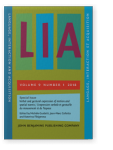Introduction published In:
Verbal and gestural expression of motion and spatial events / L’expression verbale et gestuelle du mouvement et de l’espace: New evidence from different age groups and linguistic environments / nouveaux arguments en provenance de différents groupes d’âge et de différents environnements linguistiquesEdited by Kateřina Fibigerová, Jean-Marc Colletta and Michèle Guidetti
[Language, Interaction and Acquisition 9:1] 2018
► pp. 11–21
